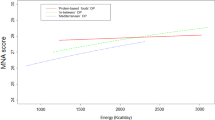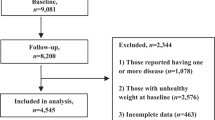Abstract
Background/objectives:
To identify and describe dietary patterns in Danish adults and to examine which demographic and health-related lifestyle factors are associated with dietary patterns.
Subjects/methods:
Data derived from the Danish national survey of diet and physical activity collected in 2003–2008 and included 1569 men and 1785 women. Diet was assessed by a 7-day pre-coded food diary. Information on age, gender, weight, height, physical activity, smoking habits, educational level and attitudes towards healthy eating habits was derived from face-to-face interviews. Principal component analysis was applied to explore dietary patterns. Associations with lifestyle factors were examined by means of multiple regression analyses.
Results:
Three major dietary patterns were identified: a ‘traditional’ pattern correlated with intake of rye bread, white bread, fat on bread, cheese, jam, cold meat, minced meat, potatoes and gravy, and cake and biscuits; a ‘health-conscious’ pattern correlated with coarse bread, fruit, vegetables, low-fat dairy, nuts, water and tea; and a ‘fast food’ pattern correlated with pizza, hamburger/spring rolls, crisps, rice and pasta, sugar-sweetened soft drinks and sweets. The ‘traditional’ pattern was positively associated with male gender and age, whereas the ‘health-conscious’ pattern was positively associated with being female, increasing age and educational level. The ‘fast food’ pattern was inversely associated with age and smoking.
Conclusions:
Three distinct dietary patterns were identified, and associated lifestyle and demographic factors were characterised. The findings are valuable in targeting future nutrition education and will enable more focused strategies in communicating food-based dietary guidelines.
This is a preview of subscription content, access via your institution
Access options
Subscribe to this journal
Receive 12 print issues and online access
$259.00 per year
only $21.58 per issue
Buy this article
- Purchase on Springer Link
- Instant access to full article PDF
Prices may be subject to local taxes which are calculated during checkout
Similar content being viewed by others
References
WHO. Diet, Nutrition and the Prevention of Chronic Diseases: Report of a Joint WHO/FAO Expert Consultation. World Health Organisation: Geneva, 2003.
WHO. Obesity: Preventing and Managing the Global Epidemic. Report of a WHO consultation. World Health Organisation: Geneva, 2000.
EFSA. Scientific Opinion on Establishing Food Based Dietary Guidelines. EFSA Panel on Dietetic Products, Nutrition and Allergies (NDA). European Food Safety Authority: Parma, 2010.
Hu FB . Dietary pattern analysis: a new direction in nutritional epidemiology. Curr Opin Lipidol 2002; 13: 3–9.
Bamia C, Orfanos P, Ferrari P, Overvad K, Hundborg HH, Tjonneland A et al. Dietary patterns among older Europeans: the EPIC-Elderly study. Br J Nutr 2005; 94: 100–113.
Charreire H, Kesse-Guyot E, Bertrais S, Simon C, Chaix B, Weber C et al. Associations between dietary patterns, physical activity (leisure-time and occupational) and television viewing in middle-aged French adults. Br J Nutr 2011; 105: 902–910.
Costacou T, Bamia C, Ferrari P, Riboli E, Trichopoulos D, Trichopoulou A . Tracing the Mediterranean diet through principal components and cluster analyses in the Greek population. Eur J Clin Nutr 2003; 57: 1378–1385.
Engeset D, Alsaker E, Ciampi A, Lund E . Dietary patterns and lifestyle factors in the Norwegian EPIC cohort: the Norwegian Women and Cancer (NOWAC) study. Eur J Clin Nutr 2005; 59: 675–684.
Fung TT, Stampfer MJ, Manson JE, Rexrode KM, Willett WC, Hu FB . Prospective study of major dietary patterns and stroke risk in women. Stroke 2004; 35: 2014–2019.
Hodge AM, English DR, O'Dea K, Giles GG . Dietary patterns and diabetes incidence in the Melbourne Collaborative Cohort Study. Am J Epidemiol 2007; 165: 603–610.
Fung T, Hu FB, Fuchs C, Giovannucci E, Hunter DJ, Stampfer MJ et al. Major dietary patterns and the risk of colorectal cancer in women. Arch Intern Med 2003; 163: 309–314.
Newby PK, Muller D, Hallfrisch J, Andres R, Tucker KL . Food patterns measured by factor analysis and anthropometric changes in adults. Am J Clin Nutr 2004; 80: 504–513.
Knudsen VK, Fagt S, Trolle E, Matthiessen J, Groth MV, Biltoft-Jensen A et al. Evaluation of dietary intake in Danish adults by means of an index based on food-based dietary guidelines. Food Nutr Res 2012; 56; doi:10.3402/fnr.v56i0.17129.
Pedersen CB . The Danish Civil Registration System. Scand J Public Health 2011; 39: 22–25.
Biltoft-Jensen A, Matthiessen J, Rasmussen LB, Fagt S, Groth MV, Hels O . Validation of the Danish 7-day pre-coded food diary among adults: energy intake v. energy expenditure and recording length. Br J Nutr 2009; 102: 1838–1846.
SAS Institute Inc SAS Institute Inc. SAS/STAT 9.2. User's Guide. SAS Institute Inc.: Cary, NC, USA, 2008.
Togo P, Heitmann BL, Sorensen TI, Osler M . Consistency of food intake factors by different dietary assessment methods and population groups. Br J Nutr 2003; 90: 667–678.
SAS Institute Inc. SAS Enterprise Guide 2006; 4: 1.
Lau C, Glumer C, Toft U, Tetens I, Carstensen B, Jorgensen T et al. Identification and reproducibility of dietary patterns in a Danish cohort: the Inter99 study. Br J Nutr 2008; 99: 1089–1098.
Osler M, Heitmann BL, Gerdes LU, Jorgensen LM, Schroll M . Dietary patterns and mortality in Danish men and women: a prospective observational study. Br J Nutr 2001; 85: 219–225.
Togo P, Osler M, Sorensen TI, Heitmann BL . A longitudinal study of food intake patterns and obesity in adult Danish men and women. Int J Obes Relat Metab Disord 2004; 28: 583–593.
Nordic Council of Ministers Nordic Nutrition Recommendations 2012. Part 1. Summary, principles and use. Nordic Council of Ministers, 2013. Available at: http://dx.doi.org/10.6027/Nord2013-009.
Irz X, Fratiglioni L, Kuosmanen N, Mazzocchi M, Modugno L, Nocella G et al. Sociodemographic determinants of diet quality of the EU elderly: a comparative analysis in four countries. Public Health Nutr 2013; 9: 1–13.
Groth MV, Fagt S, Brondsted L . Social determinants of dietary habits in Denmark. Eur J Clin Nutr 2001; 55: 959–966.
Groth MV, Fagt S, Stockmarr A, Matthiessen J, Biltoft-Jensen A . Dimensions of socioeconomic position related to body mass index and obesity among Danish women and men. Scand J Public Health 2009; 37: 418–426.
Pedersen AN, Fagt S, Groth MV, Christensen T, Biltoft-Jensen A, Matthiessen J et al. Danskernes Kostvaner 2003-2008. Hovedresultater (Dietary habits in Denmark 2003-2008. Main results) DTU Fødevareinstituttet: Søborg, Denmark, 2010.
Duvigneaud N, Wijndaele K, Matton L, Philippaerts R, Lefevre J, Thomis M et al. Dietary factors associated with obesity indicators and level of sports participation in Flemish adults: a cross-sectional study. Nutr J 2007; 6: 26.
Korn L, Gonen E, Shaked Y, Golan M . Health perceptions, self and body image, physical activity and nutrition among undergraduate students in Israel. PLoS One 2013; 8: e58543.
Mishra GD, McNaughton SA, Ball K, Brown WJ, Giles GG, Dobson AJ . Major dietary patterns of young and middle aged women: results from a prospective Australian cohort study. Eur J Clin Nutr 2010; 64: 1125–1133.
Scagliusi FB, Polacow VO, Artioli GG, Benatti FB, Lancha AH Jr. . Selective underreporting of energy intake in women: magnitude, determinants, and effect of training. J Am Diet Assoc 2003; 103: 1306–1313.
Knudsen VK, Gille MB, Nielsen TH, Christensen T, Fagt S, Biltoft-Jensen A . Relative validity of the pre-coded food diary used in the Danish National Survey of Diet and Physical Activity. Public Health Nutr 2011; 2: 1–7.
Gunnare NA, Silliman K, Morris MN . Accuracy of self-reported weight and role of gender, body mass index, weight satisfaction, weighing behavior, and physical activity among rural college students. Body Image 2013; 10: 406–410.
Due P, Heitmann BL, Sorensen TI . Prevalence of obesity in Denmark. Obes Rev 2007; 8: 187–189.
Matthiessen J, Biltoft-Jensen A, Fagt S, Knudsen VK, Tetens I, Groth MV . Misperception of body weight among overweight Danish adults: trends from 1995 to 2008. Public Health Nutr 2013; 5: 1–8.
Author information
Authors and Affiliations
Corresponding author
Ethics declarations
Competing interests
The authors declare no conflict of interest.
Additional information
Supplementary Information accompanies this paper on European Journal of Clinical Nutrition website
Supplementary information
Rights and permissions
About this article
Cite this article
Knudsen, V., Matthiessen, J., Biltoft-Jensen, A. et al. Identifying dietary patterns and associated health-related lifestyle factors in the adult Danish population. Eur J Clin Nutr 68, 736–740 (2014). https://doi.org/10.1038/ejcn.2014.38
Received:
Revised:
Accepted:
Published:
Issue Date:
DOI: https://doi.org/10.1038/ejcn.2014.38
This article is cited by
-
Identifying dietary patterns across age, educational level and physical activity level in a cross-sectional study: the Tromsø Study 2015 - 2016
BMC Nutrition (2022)
-
Dietary patterns of adults and their associations with Sami ethnicity, sociodemographic factors, and lifestyle factors in a rural multiethnic population of northern Norway - the SAMINOR 2 clinical survey
BMC Public Health (2019)
-
Socio-demographic and lifestyle determinants of dietary patterns in French-speaking Switzerland, 2009–2012
BMC Public Health (2018)
-
Associations between dietary patterns, socio-demographic factors and anthropometric measurements in adult New Zealanders: an analysis of data from the 2008/09 New Zealand Adult Nutrition Survey
European Journal of Nutrition (2018)
-
Lifestyle predictors for non-participation and outcome in the second round of faecal immunochemical test in colorectal cancer screening
British Journal of Cancer (2017)



